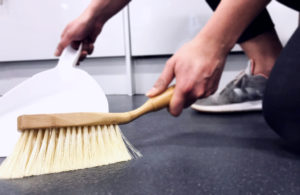The main sources of dust in your home
 We dust our homes weekly, if not more often. But have you ever wondered where all the dust comes from? It seems like it magically appears all over your shelves, tables and floors and no matter how much and how often you vacuum and dust everything, in less than a few days, it is right back.
We dust our homes weekly, if not more often. But have you ever wondered where all the dust comes from? It seems like it magically appears all over your shelves, tables and floors and no matter how much and how often you vacuum and dust everything, in less than a few days, it is right back.
In this article we will take a closer look at what dust really is made of, which are the main sources of dust and household grime and how it spreads around your home.
Household dust is simply a bunch of small particles that are created by a number of objects around the house. Most of them end up on the floor but the smaller particles float around the air and end up on higher surfaces such as shelves, tops of cupboards and appliances. What is more, as we walk or change our bed linen, for example, the movement that we create sends all the dust up and around. You have probably seen dustlight and how fast the motes move.
Let’s see which are the main sources of dust:
- Dust from the street, garden or yard
- Fibres from clothes and bed linen
- Carpets, rugs and upholstery
- Food crumbs
- Dead skin, hair and other debris from our bodies and pets
- Tissues, kitchen rolls, toilet paper
- Dead insect parts
- Fungi and bacteria
- Flowers, leaves and pollen
- Microplastic
- Ash
Asphalt and concrete wear off as vehicles constantly drive on them. Same goes for pavements. These rough materials are in fact quite vulnerable to the elements. Frost, humidity, heat and rain break them down into small fragments and even though most of them get washed away, a part of those particles becomes airborne and finds its way into our homes.
When we walk around in the garden, a large amount of mud and soil get stuck to our soles and as we bring it into our home, it dries out and becomes one of the main dust contributors.
Most clothes are made of woven or knitted raw fibres like wool, cotton, polyester etc. Such fabrics shed fibres all the time and especially as we dress and undress and when we change our bed linen. That is exactly why the bedroom is always one of the dustiest rooms in the house and requires extended cleaning.
Just like clothing, rugs and carpets are made of synthetic or natural textile. They also shed fibres so whenever we walk around or sit on the couch, a large amount of airborne is sent around the room. Not to mention that the fabric materials hold onto already made dust that has landed on it so double amounts of grime are shooted out in the air.
Cereal, bread, cookies and cake, as well as other foods that crumble are another great source of dust on the floor. They fall down and keep getting crushed until they become tiny particles that easily spread around.
We constantly shed hair, eyelashes and dead skin cells. So do our pets. As new skin cells grow underneath, the old, dry ones are falling off. Skin and hair are a huge contributor to dust at home.
Every time you rip a piece from your kitchen roll, for example, little paper particles are sent in the air. Those paper rolls are made from wood pulp fibres and as we use them the paper disintegrates and wood fibres break off.
It is inevitable to have insects in the house. You know how they are able to get anywhere so imagine all the random places they end up dying at. When insects die, they dry out and their outer skeletons get broken up and little particles become airborne dust that contributes to your overall indoor pollution.
In moist homes, mould and bacteria can occur in various places, causing damage to timber, furniture and walls. Spored from fungi, as well as the crumbles from the damaged objects greatly contribute to the amount of dust in your house.
During the summer, pollen and flower petals might find their way inside. In autumn, dried leaves may also get in your house. All those will dry out and crumble up, causing small particles turning into dust. This also happens with indoor plants.
Yes, you have probably heard how dangerous and harmful microplastic is for the ocean and marine life. In fact, all plastic utensils, bags and appliances we have also shed tiny plastic particles. That is caused by abrasion and wear and tear.
When having a stove or a fireplace at home, ash will be there no matter how often you clean it. It is extremely light and easily spreads in the air. It not only turns into dust, but also sticks to walls and ceilings.
How to effectively get rid of dust:
- Don’t use a dry cloth when dusting. Dust won’t stick to it and will send it back in the air right after you wipe it. Use a damp cloth.
- Use your vacuum cleaner. The attachment with the soft brush at the end is perfect for cleaning dust.
- Always vacuum after you dust. Even if you use a damp cloth, a small amount will still escape and fall off. Make sure you vacuum so that it does not keep spreading around.
